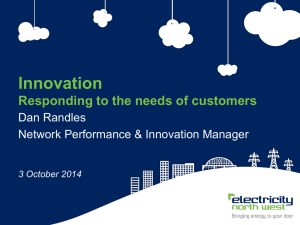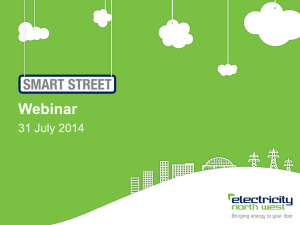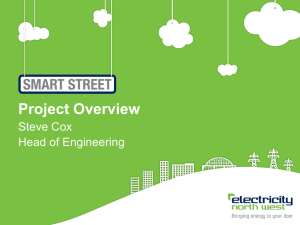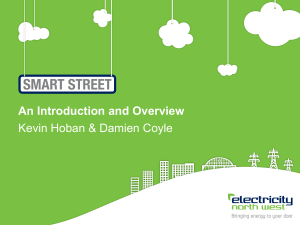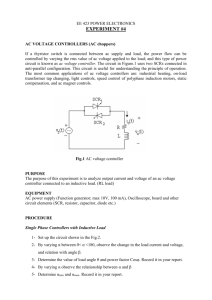Optimising grids - Electricity North West
advertisement
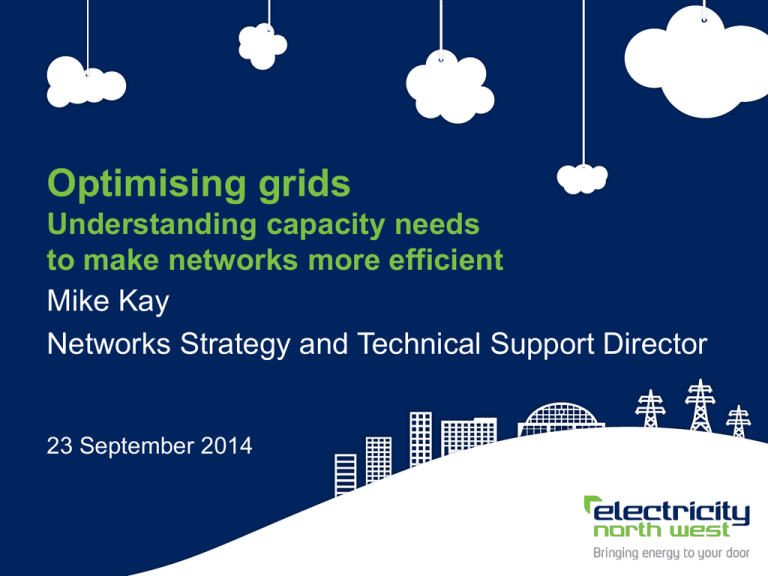
Optimising grids Understanding capacity needs to make networks more efficient Mike Kay Networks Strategy and Technical Support Director 23 September 2014 1 Connecting the North West 5 million 2.4 million 23.5 terawatt £12.3 billion assets 2 UK energy challenges + 2014 1/3 gas 1/3 electricity 1/3 oil 2020 2050 34% CO2 reduction 80% CO2 reduction 40% from wind / PV Significant and new nuclear increase in 5% transport 120,000 electricity demand electric vehicles 26 million smart meters fitted RIIO-ED1 Traditional reinforcement unaffordable DG represents the most immediate challenge Uncertainty in future demand and generation Difficult to predict demand More pressure to meet customers’ needs at minimum cost 3 Our innovation strategy Offer new services and choice for the future ‘Fit and forget’ Generate value for customers now Maximise use of existing assets Delivering value to customers Proven technology deployable today Innovative solutions to real problems www.enwl.co.uk/thefuture 4 Our smart grid programme Leading work on developing smart solutions Deliver value from existing assets Three flagship products Customer choice £30 million Capacity to Customers 5 Capacity to Customers Capacity to Customers Technical innovation Utilised capacity Current demand New commercial contracts Latent capacity Combines proven technology and new commercial contracts Remote control equipment on HV circuit and close the NOP Innovative demand side response contracts Releases significant network capacity Enhanced network management software Allow us to control customer’s consumption on a circuit at the time of fault Facilitates connection of new demand and generation without reinforcement Effectively doubles the available capacity of the circuit 6 Capacity to Customers and beyond When is C2C cost ... or when should effective ...? we reinforce? Working with University of Manchester to develop economic methodology 7 Customer Load Active System Services CLASS is seeking to demonstrate that electricity demand can be managed by controlling voltage…without any discernible impacts on customers Reduces demand at time of system peak Demand reduction System balancing support Provides a demand reduction capability to support system balancing Voltage control Mitigates excessive voltages when generation is high and demand is low 8 Smart Street New controllable switching devices stabilise voltage Allows us to lower voltage levels Enables networks and appliances to work in harmony Low cost Quick fit Minimal disruption Low carbon Low loss Invisible to customers Faster connection of low carbon technologies 9 How, when and where to manage LV voltage Analysis shows much of LV network can accommodate PV Challenge for PV is voltage ‘Connect and manage’ approach developed to avoid connection delays Investigating customers’ perceptions of voltage and if standards are appropriate 10 Fault Level Active Response (FLARE) FLARE is the first UK demonstration of an active fault level management solution that avoids traditional network reinforcement Faster LCT adoption Less disruption Lower bills 11 Summary • Increasingly uncertain and variable capacity requirements • Need to respond more quickly • Beyond predictable demand growth • Developing solutions to optimise network • Intelligence to understand when to deploy them Challenge Strategy Solutions Benefits • Maximising use of existing assets • Offering choice to customers • Leverage learning from other projects and DNOs • Lower energy bills • More reliable supply • Reinforcement savings 12 Want to know more? e futurenetworks@enwl.co.uk www.enwl.co.uk/thefuture 0800 195 4141 @ElecNW_News linkedin.com/company/electricity-north-west facebook.com/ElectricityNorthWest youtube.com/ElectricityNorthWest e Thank you for your time and attention 13 14
